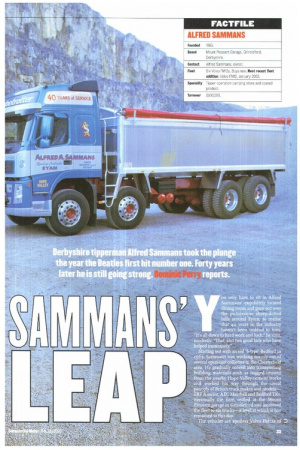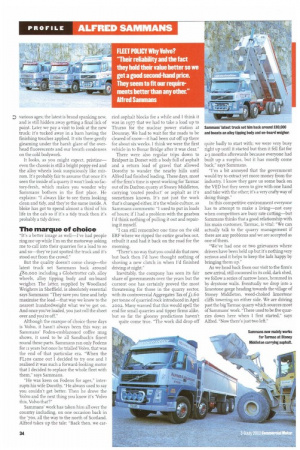Derbyshire tipperitaii Alfred Sammans took the plunge the year the Beatles first hit number one. Forty years
Page 33

Page 34

If you've noticed an error in this article please click here to report it so we can fix it.
later he is still going strong. reports.
ou only have to sit in Alfred Sammons' exquisitely located dining room and gaze out over the picturesque sheep-dotted hills around Eyam, to realise that 40 years in the industry haven't been unkind to him. "It's all down to hard work and luck," he says, modestly. "That, and two good lads who have helped immensely."
Starting out with an old '5-type' Bedford in 1963, Sarrunans was working mainly out of several open-cast collieries in the Chesterfield area. He gradually moved into transporting building materials such as bagged cement from the nearby Hope Valley cement works and worked his way through the usual panoply of British truck makes and models_ ERF A series, AEC Marshall and Bedford TKs. Eventually the firm settled at the Mount Pleasant garage in Grindleford and increased the fleet to six trucks—a level at which it has remained to this day.
ehicles are spotless Volvo EMI2s of 0 various ages; the latest is brand spanking new, and is still hidden away getting a final lick of paint. Later we pay a visit to look at the new truck: it's tucked away in a barn having the finishing touches applied. It sits there gently gleaming under the harsh glare of the overhead fluorescents and our breath condenses on the cold bodywork.
It looks, as you might expect, pristine— even the chassis is still a bright poppy-red and the alloy wheels look suspiciously like mirrors. It's probably fair to assume that once it's seen the inside of a quarry it won't look so factory-fresh, which makes you wonder why Sammans bothers in the first place. He explains: "I always like to see them looking clean and tidy, and they're the same inside. A bloke has got to spend almost a third of his life in the cab so if it's a tidy truck then it's probably a tidy driver.
The marque of choice
"It's a better image as well—I've had people ring me up while I'm on the motorway asking me to call into their quarries for a load to so and so—they've just spotted the truck and it's stood out from the crowd."
But the quality doesn't come cheap—the latest truck set Sammans back around i8o,000 including a Globetrotter cab, alloy wheels, alloy tipping body and on-board weigher. The latter, supplied by Woodland Weighers in Sheffield, is absolutely essential says Sammons: "They save you time and help maximise the load—that way we know to the nearest hundredweight what we've got on. And once you've loaded, you just roll the sheet over and you're off" Although the marque of choice these days is Volvo, it hasn't always been this way; as Sammans' Foden-emblazoned coffee mug shows, it used to be all Sandbach's finest round these parts. Sammans ran only Fodens for It years but once he triallecl Volvo, that was the end of that particular era. "When the FLicis came out I decided to try one and I realised it was such a forward-looking motor that I decided to replace the whole fleet with them," says Sammans.
"He was keen on Fodens for ages," interrupts his wife Dorothy. "He always used to say you couldn't get better. Then he drove the Volvo and the next thing you know it's 'Volvo this, Volvo that'!"
Sammans' work has taken him all over the country including, on one occasion back in the '7os, all the way to the north of Scotland. Alfred takes up the tale: "Back then, we car.
ried asphalt blocks for a while and I think it was in 1977 that we had to take a load up to Thurso for the nuclear power station at Dounray. We had to wait for the roads to be cleared of snow—it had been cut off up there for about six weeks. I think we were the first vehicle in to Bonar Bridge after it was clear.'
There were also regular trips down to Bridport in Dorset with a body full of asphalt and a return load of gravel that allowed Dorothy to wander the nearby hills until Alfred had finished loading. These days, most of the firm's time is spent working for Tarmac out of its Darlton quarry at Stoney Middleton, carrying 'coated product' or asphalt as it's sometimes known. It's not just the work that's changed either, it's the whole culture, as Sammans comments: "I used to put in loads of hours; if I had a problem with the gearbox I'd think nothing of pulling it out and repairing it myself.
"I can still remember one time on the old ERF where we ripped the entire gearbox out, rebuilt it and had it back on the road for the morning.
"There's no way that you could do that now, but back then I'd have thought nothing of shoving a new clutch in when I'd finished driving at night."
Inevitably, the company has seen its fair share of governments over the years but the current one has certainly proved the most threatening for those in the quarry sector, with its controversial Aggregates Tax of fi.6o per tonne of quarried rock introduced in April 2002Many warned that this would spell the end for small quarries and tipper firms alike, but so far the gloomy predictions haven't
quite come true. "The work did drop off quite badly to start with; we were very busy right up until it started but then it fell flat for 2-3 months afterwards because everyone had built up a surplus, but it has mostly come back," says Sammans.
"I'm a bit annoyed that the government would try to extract yet more money from the industry. I know they gave us some back on the VED but they seem to give with one hand and take with the other; it's a very crafty way of doing things."
In this competitive environment everyone has to attempt to make a living—not easy when competitors are busy rate cutting—but Sammans thinks that a good relationship with his main customer, Tarmac, is vital: "We can actually talk to the quarry management if there are any problems and we are accepted as one of them.
"We've had one or two grievances where drivers have been held up but it's nothing very serious and it helps to keep the lads happy by bringing them up."
As we head back from our visit to the firm's new arrival, still cocooned in its cold, dark shed, we follow a series of narrow lanes, hemmed in by drystone walls. Eventually we drop into a limestone gorge heading towards the village of Stoney Middleton, weed-choked limestone cliffs towering on either side. We are driving past the big Tarmac quarry which sources most of Sammans' work. "There used to be five quarries down here when I first started," says Alfred. "Now there's just two left."




































































































































































